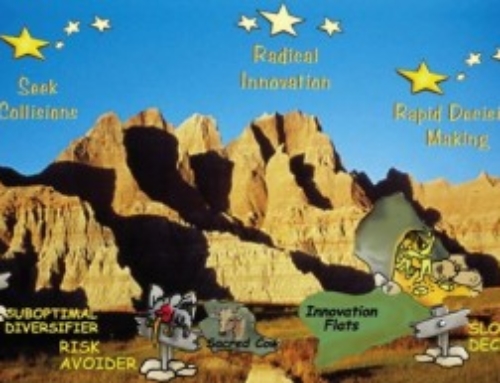In Part 1 of this Article, we explored the first four principles of leadership to exit the Badlands. The final four are discussed below.
5. Radical Innovation
 As you exit the Badlands, it is far less dangerous to experiment with radical innovations in a core business than it is not to. Innovations, especially radical ones, are the milestones of crossing successfully into the future, where the process of creative destruction is fast and furious. The scaffolding for business models of the future are built from radical innovations. Globalization and destruction of the old era in the Badlands we are now leaving results in new industries, hybrid industries, and different types of organizations we will see created in the next 10 years. This occurs not just in business, but with all of our social institutions that have failed in the Badlands in the last 10 years.
As you exit the Badlands, it is far less dangerous to experiment with radical innovations in a core business than it is not to. Innovations, especially radical ones, are the milestones of crossing successfully into the future, where the process of creative destruction is fast and furious. The scaffolding for business models of the future are built from radical innovations. Globalization and destruction of the old era in the Badlands we are now leaving results in new industries, hybrid industries, and different types of organizations we will see created in the next 10 years. This occurs not just in business, but with all of our social institutions that have failed in the Badlands in the last 10 years.
In order to keep up with the emerging business environment of the future, some portion of your innovation portfolio must be radical to fit. Radical innovation comes in many forms, including:
- innovation that changes customer expectations,
- that invents new industries,
- that reinvents industry economics,
- and that invents new business models and that redefines competitive advantage.
Applying the principle of radical innovation means making strategic information and targeted business results accessible and visible to all. Creating a free flow of strategic information is part of cultural change, as is making sure that both the technology infrastructure and the “outfrastructure” (the interface between the company and its external resource network) facilitate easy connectivity and interactivity.

6. Engage Cultures
Doing business across cultures adds another element of volatility. The good news, however, is that leadership qualities suitable for exiting the Badlands also help leaders navigate the rough weather systems generated by multiculturalism, particularly in the diversity of the emerging markets. Authenticity, courage, resilience, adaptability, true empathy and persistence—these six traits will help leaders engage productively with one another. Other useful qualities that we haven’t stressed include a sense of humor, discernment, and self-confidence.
Robust self-confidence is critical to the process of cultural learning, since even the most seasoned leader can feel a sense of failure as global relationships struggle to work. The very act of engaging in cultural learning results in anxiety as part of a natural human process. Many potential global leaders ultimately fail because they are not able to learn enough about other cultures. Thus, they are unable to be effective in situations when leadership is shared and where innovation across cultures must be achieved. In this increasingly global business world, the goal must be maximum inclusion of all cultures within a worldwide web of alliances.
Engaging other cultures fully will be essential to making savvy decisions about when to customize products or services, and how to segment markets in different countries. True cultural empathy, being able to put yourself in another person’s shoes, is one of the critical skills of the future. This is particularly challenging in the diverse emerging markets where many business leaders have little experience. If you don’t have true knowledge based on experience, you will create a framework that only fits the culture in your mind. It will not fit the one that can be found in the real world all around you, wherever it is you live and work.
7. Rapid Decision Making
While volatile conditions can impede or obstruct decision-making, it is critical to make choices that accelerate action as quickly as possible. Leaders want to nurture an action-oriented stance throughout their whole company. For some, the fear of risk and making the wrong decision may be a paralyzing force, but as you exit the Badlands it is better to act, evolve, and move on than to sit idle in the harsh sun.
When good leaders make mistakes, which they will, they fix them fast and keep moving. A wealth of research in both business behavior and psychology clearly points out that attitudes follow behavior, not the other way around. To create a culture of action, push ahead and act on decisions on the spot. This is, of course, easier said than done. Our legacy problem with decision-making is that we favor talking over acting. Talk should mobilize action, not substitute for it.
One way to facilitate rapid decision-making is to persistently and intelligently simplify complexity, thus clearing the way for tangible action. Ample and direct goals allow people to make forward progress. Appreciating the value of common sense and using language that is simple, direct, and clear acts as lubrication for action. It is all too common for people to think that those who articulate in the language of complexity have the right answer and are smarter. This myth needs to be constantly debunked, for it will always slow implementation of action. Decision-making needs to be distributed to those who are closest to both the issues and the action, regardless of their ability to perform in a meeting.
Maintaining a free flow of information and access is critical. In some companies, people hoard information, equating it with power and prestige. To make things worse, in large companies with layers of bureaucracy and complex structures, rules tend to replace thinking. The goal in a complex and uncertain environment is to keep as many good options open as possible, which sometimes means postponing any choices that might limit opportunities down the road.
8. Disciplined Execution
Exiting the Badlands is paradoxical, in that to emerge and thrive requires both the discipline for great implementation and a climate that leads to radical innovation. It is not uncommon for companies and leaders to insufficiently comprehend what they know how to do, which leads to assumptions about their ability to achieve new strategies without building new competencies.
- Just how transferable are your core competencies to each new opportunity?
- How well matched are they to the likely paths of evolution your industry might take?
- What are the unique and most valuable benefits that you deliver to customers?
Closing competency gaps can solve a great many execution problems.
Many execution failures are due to job assignments that are too fragmented or too boring. Often, too, there is not enough authority delegated to function with any degree of independence. Enhance execution by coaching people—the right people—to work only from their strengths. Unfortunately, most workers and leaders are keenly aware of weaknesses, and less tuned in to strengths. Good leaders need the courage to reorganize people in a way that boldly leverages their strengths and passions.
Don’t over rely on teams. The coordinated work of highly skilled individuals working more or less on their own has a prime role in a turbulent environment. They can work swiftly, and speed is of the essence as you exit the Badlands. At the same time, once you get a high-performance team in which the individuals like working together, find ways to redeploy them to other tasks. This kind of team is rare – and powerful.
Demand contingency thinking from yourself and from others. Things will change in surprising ways, and the ability to engage quickly in alternatives allows everyone to steer around the dangerous shifts in terrain and keep moving toward the end goal.
Parting Thoughts…
What kind of leader will you become? How will you use the alchemy of this journey to exit the Badlands to become a leader of a future that won’t resemble the past? Your capacity to lead is not centered on skills of the past, but more about attitude and mind-sets that let you see in new ways, and learn and inspire others to move on despite the uncertainty of this forbidding terrain. This means you must confront and manage your own stress and fear. Let go of old ideas and out worn roles and seek collisions by learning to connect with new and different kinds of people who can help you change and grow.
Spend time to harvest the lessons as your travel ahead. Here are some lessons and insights learned by other successful leaders who have gone before you.





